Haben Sie schon einmal versucht, einen Ihrer WordPress-Beiträge zu öffnen, nur um von einem 404-Fehler begrüßt zu werden? Manchmal erleben wir das, wenn wir an unseren eigenen WordPress-Seiten arbeiten oder unseren Benutzern helfen
Dieser Fehler tritt auf, wenn Sie auf Ihren WordPress-Administrationsbereich und Ihr Blog zugreifen können, aber wenn Sie versuchen, einen bestimmten Beitrag zu öffnen, erhalten Sie die Meldung „404 Not Found“.
Es kann frustrierend sein, wenn Ihre Inhalte scheinbar verschwinden, aber wir haben einige Lösungen gefunden, um dieses Problem zu beheben. In dieser vollständigen Anleitung zeigen wir Ihnen, wie Sie WordPress-Beiträge mit 404-Fehlern beheben können.

Warum erhalten meine WordPress-Beiträge einen 404-Fehler?
Es gibt mehrere Gründe, warum Ihre Beiträge in WordPress einen 404 „Seite nicht gefunden“-Fehler anzeigen. Diese können sein:
- Konflikte mit Plugins oder Themes: Manchmal können Plugins oder Themes, die Sie auf Ihrer Website installiert haben, die Handhabung von Permalinks durch WordPress beeinträchtigen. Dies kann zu fehlerhaften Links und 404-Fehlern führen.
- Probleme mit benutzerdefiniertem Code: Wenn Sie Ihrer Website benutzerdefinierten Code hinzugefügt haben, kann es sein, dass der Code Fehler enthält, die sich auf Permalinks auswirken oder andere Konflikte verursachen, was zu 404-Fehlern für Ihre Beiträge führt.
- Probleme mit Ihrer .htaccess-Datei: Die .htaccess-Datei spielt eine Rolle dabei, wie WordPress URLs strukturiert. Wenn diese Datei beschädigt ist oder fehlt, kann dies zu 404-Fehlern für Ihre Beiträge oder Seiten führen.
Wie man alle WordPress-Beiträge mit 404-Fehlern findet
Bevor wir zu den Lösungen kommen, wäre es gut, herauszufinden, ob der Fehler nur bei einem oder zwei Beiträgen oder bei mehreren Beiträgen auftritt. Auf diese Weise können Sie den Umfang des Problems bestimmen und die am besten geeignete Lösung wählen.
Eine einfache Möglichkeit, dies herauszufinden, ist die Verwendung der Google Search Console. Wenn Sie Ihre Website noch nicht bei Google Search Console angemeldet haben, lesen Sie unseren Leitfaden zum Hinzufügen Ihrer WordPress-Website zu Google Search Console.
Sobald der Google-Bot Ihre Website gecrawlt und indexiert hat, liefert Ihnen die Google Search Console detaillierte Informationen über die Leistung Ihrer Website, einschließlich aller 404-Fehler, auf die sie stößt.
Um herauszufinden, bei welchen Beiträgen 404-Fehler auftreten, können Sie sich im Dashboard der Search Console anmelden. Navigieren Sie dann zum Bericht „Seiten“ und Sie sehen eine detaillierte Liste aller Fehler.
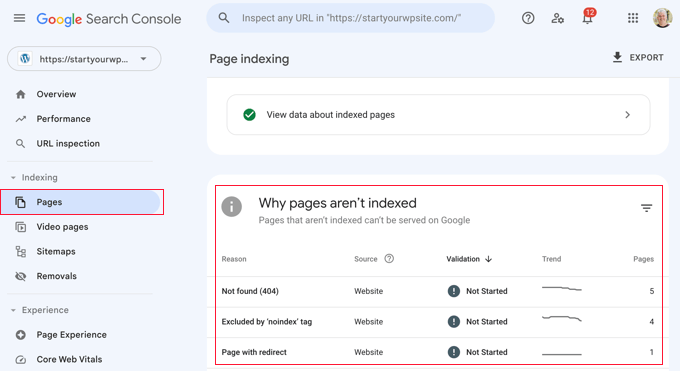
Weitere Informationen finden Sie in unserer Liste mit Tipps für die Verwendung der Google Search Console zur Steigerung des Website-Traffics, die auch einige Tipps zur Behebung von 404-Fehlern mit dem Tool enthält.
Sehen wir uns also an, wie man WordPress-Beiträge mit 404-Fehlern beheben kann. Sie können die Links unten verwenden, um direkt zu den verschiedenen Lösungen zu springen:
Keine Zeit, 404-Fehler selbst zu beheben? WPBeginner Pro Services kann helfen! Mit unserem erschwinglichen WordPress-Notfallsupport können Sie Experten beauftragen, 404-Fehler, defekte Links, Weiterleitungsprobleme und vieles mehr zu beheben. Hören Sie auf, sich über WordPress-Probleme zu ärgern und lassen Sie sie beheben! Vereinbaren Sie noch heute einen Notfall-Support für WordPress!
Methode 1: Suchen Sie nach Plugin- oder Theme-Konflikten und benutzerdefinierten Code-Problemen
Manchmal können Plugins, Themes oder benutzerdefinierter Code, den Sie zu Ihrer WordPress-Website hinzugefügt haben, Permalinks beeinträchtigen oder Konflikte verursachen, die zu 404-Fehlern führen. Wir haben das sogar schon selbst erlebt, als wir Tools auf unserer Demo-Website getestet haben.
Eine Möglichkeit, dieses Problem zu lösen, besteht darin, Plugins vorübergehend zu deaktivieren. Plugins können manchmal stören, wie WordPress mit Links umgeht.
Nachdem Sie die Plugins deaktiviert haben, können Sie sie nacheinander reaktivieren und dabei überprüfen, ob der 404-Fehler nach der Aktivierung der einzelnen Plugins erneut auftritt. Wenn der Fehler nach der Aktivierung eines bestimmten Plugins auftritt, könnte dieses der Übeltäter sein.
Sie können dann eine schnelle Google-Suche nach Lösungen für dieses Plugin durchführen oder den Plugin-Entwickler um Unterstützung bitten.
Auch Ihr WordPress-Theme könnte die Ursache für den Konflikt sein.
Um das zu überprüfen, können Sie vorübergehend zu einem Standard-WordPress-Theme wie Twenty Twenty-Three oder Twenty Twenty-Four wechseln. Dazu müssen Sie nur auf Darstellung „ Themes gehen und bei einem Standard-Theme auf „Aktivieren“ klicken.

Wenn der 404-Fehler mit dem Standard-Theme verschwindet, deutet dies auf einen möglichen Konflikt mit Ihrem aktuellen Theme hin. Sie können dann versuchen, das Problem mit dem Theme zu beheben oder ein anderes Theme zu verwenden.
In unserer Expertenauswahl der beliebtesten WordPress-Themes finden Sie Empfehlungen.
Wenn Sie kürzlich Codeschnipsel in Ihre Website eingefügt haben, kann es sein, dass der Code Fehler enthält, die die 404-Fehler verursachen. Schauen Sie sich den hinzugefügten Code genau an und prüfen Sie, ob Sie Fehler finden können.
Der sicherste Weg, Code-Schnipsel in WordPress einzufügen, ist das WPCode-Plugin. Mit diesem Plugin können Sie benutzerdefinierten Code einfügen, ohne direkt mit den Themadateien zu arbeiten, wodurch das Risiko, dass Ihre Website beschädigt wird, verringert wird.
Und wenn WPCode einen Fehler in Ihrem Code entdeckt, wird das Snippet automatisch deaktiviert und Sie werden aufgefordert, es zu überprüfen. Sie können auch den Testmodus verwenden, um zu prüfen, ob Ihr Code funktioniert, bevor Sie ihn auf Ihre Live-Website übertragen.

Wenn keine dieser Lösungen funktioniert, fahren Sie mit der nächsten Methode fort, bei der wir Ihre Permalink-Einstellungen überprüfen werden.
Methode 2: Reparieren Sie Ihre Permalink-Einstellungen
WordPress-Beiträge können aufgrund von Problemen mit Rewrite-Regeln in Ihrer .htaccess-Datei 404-Fehler zurückgeben. In den meisten Fällen können Sie das Problem beheben, indem Sie Ihre Permalink-Einstellungen aktualisieren.
Gehen Sie einfach zu Einstellungen “ Permalinks in Ihrem WordPress-Admin und klicken Sie auf die Schaltfläche „Änderungen speichern“.

Es ist nicht notwendig, die Permalink-Einstellungen selbst zu ändern. Dadurch werden Ihre Permalink-Einstellungen aktualisiert und die Rewrite-Regeln geleert.
In den meisten Fällen behebt diese Lösung den 404-Fehler bei WordPress-Beiträgen. Wenn es bei Ihnen jedoch nicht funktioniert, müssen Sie wahrscheinlich Ihre .htaccess-Datei manuell aktualisieren.
Methode 3: Aktualisieren der WordPress-.htaccess-Datei
Bevor Sie beginnen, sollten Sie eine Sicherungskopie Ihrer WordPress.htaccess-Datei erstellen. Wenn etwas schief geht, können Sie die ursprüngliche Datei leicht wiederherstellen.
Nun müssen Sie eine Verbindung zu Ihrem Server herstellen, indem Sie einen FTP-Client wie FileZilla oder die Dateimanager-App in Ihrem WordPress-Hosting-Dashboard verwenden.
Als Nächstes müssen Sie die Datei .htaccess finden und bearbeiten, die sich am selben Ort wie die Ordner /wp-content/ und /wp-includes/ befindet.
Klicken Sie einfach mit der rechten Maustaste auf die Datei und wählen Sie „Dateiberechtigungen“.
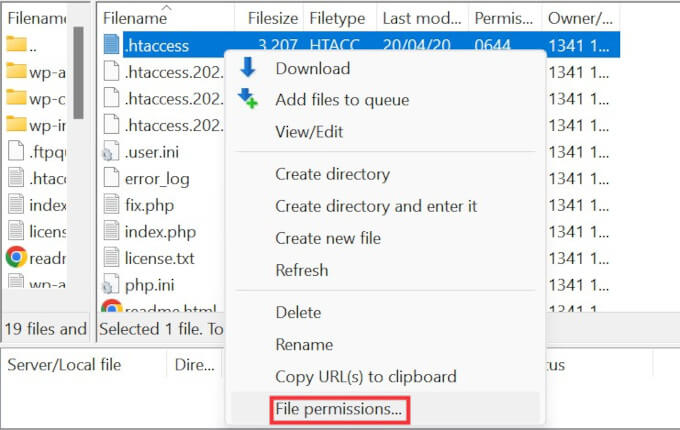
Sie können die Datei schreibbar machen, indem Sie ihre Berechtigungen auf 666 ändern.
Geben Sie einfach „666“ in das Feld „Numerischer Wert“ ein und klicken Sie dann auf „OK“.

Dann müssen Sie die Schritte der ersten Methode unseres Tutorials wiederholen. Vergessen Sie danach nicht, die Berechtigungen wieder auf 660 zu ändern.
Sie können die Datei auch bearbeiten und ihr Code hinzufügen.
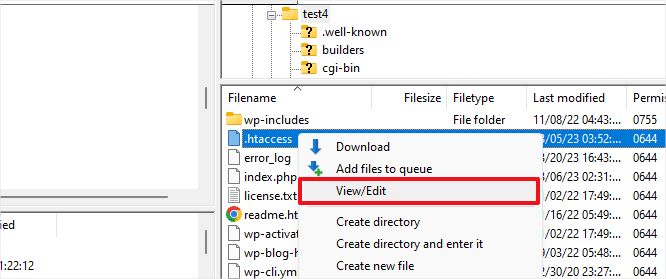
Nachdem Sie die .htaccess-Datei mit einem Texteditor geöffnet haben, fügen Sie einfach diesen Code ein:
# BEGIN WordPress
<IfModule mod_rewrite.c>
RewriteEngine On
RewriteBase /
RewriteRule ^index\.php$ - [L]
RewriteCond %{REQUEST_FILENAME} !-f
RewriteCond %{REQUEST_FILENAME} !-d
RewriteRule . /index.php [L]
</IfModule>
# END WordPress
Methode 4: Kontaktieren Sie Ihren Hosting-Anbieter
Wenn keine der oben genannten Lösungen das Problem der 404-Fehler bei WordPress-Beiträgen behoben hat, empfehlen wir Ihnen, sich an Ihren WordPress-Hosting-Anbieter zu wenden. Möglicherweise liegt ein Fehler auf dessen Seite vor, oder er kann Ihnen bei der Fehlerbehebung helfen.
Bitte lesen Sie auch unseren Leitfaden, wie Sie richtig nach WordPress-Support fragen und diesen auch erhalten.
Methode 5: Aktivieren Sie mod-rewrite (lokale WordPress-Installation)
Wenn Sie einen lokalen Server zu Testzwecken verwenden, müssen Sie mod_rewrite in der Apache-Konfiguration Ihrer MAMP-, WAMP- oder XAMPP-Site aktivieren.
Dies ermöglicht WordPress, saubere URLs zu generieren und den 404-Fehler für Beiträge und Seiten auf Ihrem lokalen Server zu vermeiden.
Wie Sie dies tun, hängt von der von Ihnen verwendeten Plattform ab. Benutzer von XAMPP können ihr Kontrollpanel öffnen und unter „Aktionen“ auf die Schaltfläche „Konfig“ klicken. Wählen Sie dann „Apache (httpd.conf)“.
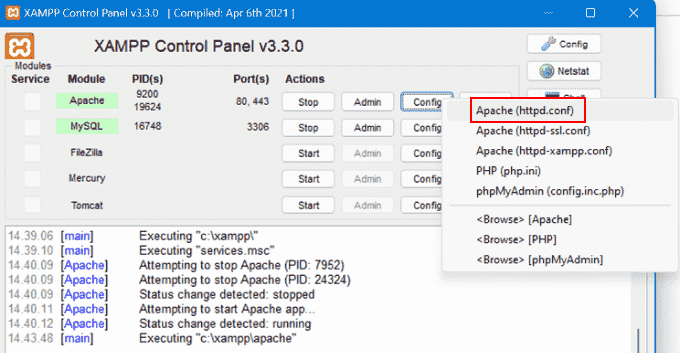
Als Nächstes müssen Sie diese Zeile #LoadModule rewrite_module modules/mod_rewrite.so finden und das ‚#‘ entfernen, um sie zu entkommentieren.
Dadurch wird mod_rewrite geladen.
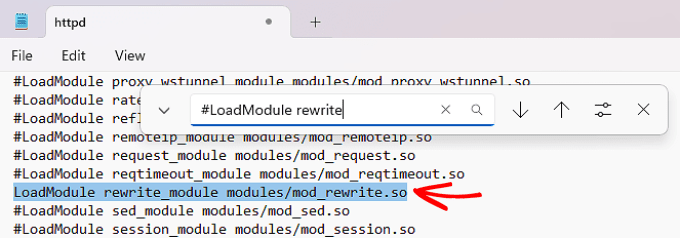
Suchen Sie dann alle Instanzen von AllowOverride None und ändern Sie sie in AllowOverride All.
Der Wert „Alle“ bedeutet, dass alle Direktiven überschrieben werden können.

Danach können Sie die Datei httpd.conf speichern und schließen. Danach klicken Sie im XAMPP-Kontrollfeld auf „Stop“ für das Apache-Modul und erneut auf „Start“, um es neu zu starten.
Gehen Sie dann zurück zu Ihrem Admin-Dashboard, um zu sehen, ob Ihre Permalinks funktionieren.
Video-Anleitung
Wenn Sie eine visuelle Anleitung benötigen, sehen Sie sich einfach das folgende Video an.
Wir hoffen, dass dieser Artikel Ihnen geholfen hat, die 404-Fehler in WordPress zu beheben. Vielleicht interessieren Sie sich auch für unseren Leitfaden zu den häufigsten WordPress-Fehlern und deren Behebung sowie für unsere Expertenauswahl der besten WordPress-Plugins für das Wachstum Ihrer Website.
Wenn Ihnen dieser Artikel gefallen hat, dann abonnieren Sie bitte unseren YouTube-Kanal für WordPress-Videotutorials. Sie können uns auch auf Twitter und Facebook finden.





Robert
Well, your tip saved me hours of searching – many thanks
Nima Arefi
Thank’s you saved my life :d
Juan
Hello, I have a problem since I migrate the website from localhost to a server, the main page looks good but the menu is not displayed but the links do not work always throws error 404.
They can help me, this is a cause of a migration from a local server.
Marissa
I can’t thank you enough for such a simple tutorial!! Everything else I found made it seem so difficult. I recently switched from http to https and it has been one problem after another..
WPBeginner Support
Hi Marissa,
Glad you found this tutorial helpful. Don’t forget to join us on Twitter for more WordPress tips and tutorials.
Admin
Rick
I didn’t have an .htaccess file so I created one with the info you provided above; then uploaded it and the site works perfectly again. Thanks!
Curtis
Hi I have done all the above and noticed the bit of text to copy and paste was already in there! It still is not working and im stressing out!
Tibi
I’ve done the same thing and nothing changed, the home page still not found
Please contact me if you find a solution
Patrick
Wow. This really saved my bacon. Thank you so much for the tip on simply saving the permalinks page. Incredible advice!
Alexis
hello! i’ve reset permalinks many times to deal with the 404 error. this time when i hit save a file downloaded to my computer: options-permalink.php and the site broke. just got a white screen and each time a file downloaded. finally i got the default permalinks to work but this is not a great solution. does this sound familiar to you? tech support didn’t think it was the .htaccess file but i’m not convinces. moved site from one host to another. any help would be much appreciated.
Mike Birdsall
How do I update settings if I can’t log into the WP admin. I get the 404 error when going to /wp-admin
Kelly
So helpful!! thank you!!!!!!
seun
Hello, please help, i seem not getting solution through this tutorial cos i can‘
t access my dashboard, i keep getting this message any site directory i open.
Not Found
The requested URL /index.php was not found on this server.
Additionally, a 404 Not Found error was encountered while trying to use an ErrorDocument to handle the request.
Nukak
if you cannot access your dashboard. your issue is most likely a plugin issue. go to phpAdmin and disable all plugins.
this link might help you https://www.wpbeginner.com/plugins/how-to-deactivate-all-plugins-when-not-able-to-access-wp-admin/
once deactivated and you log back in you can then activiate the plugins that you need. all your initial settings before you got locked out of yur site would still remain in tact. all the best.
Clint
Thank you, just clicking save on my permalink page (which has been customised for years) worked immediately.
Chris Keeble
Perfect!
Clicking Save Changes on Settings > Permalinks works first time.
tamim
Wow! that’s a great solution.
Jason
Hi, I was having the 404 error problem. Homepage works fine, all other links have the 404 error. Tried the method you suggested in wordpress settings permalinks and click save changes but it didn’t work for me.
Saw some post earlier about sync the htaccess file through the webhosting settings page somewhere but don’t really know how to do it. Any advice? Thanks
Mohamad Zidani
Hi
I was using Fv Top Level Cats, when i removed still redirection worked from
example.com/category/tech to
example.com/tech.
i try your solution and it doesn’t work.
Joerg Naussed
the 404 appear right away what happen?
Tamara
That worked!! Thank you
Lijo Jose
Thank you, My problem was solved
Mariana Cervantes
Thank you so much!!!! My problem was fixed with the permalink solution
Michael
If this error is affecting your login page, go to .htaccess and remove:
„deny from all“
„allow from 00.00.00.00“
Matt Kay
Fantastic – I had moved my site from one server to another and started getting worried about 404 errors. The fix worked perfectly – so easy!
Bienvenido
A very simple answer to a hair pulling issue. Thanks a bunch. BTW this issue started after I installed BJ Lazy Loading.
Gail Gardner
Thank you! This did the trick.
Ahmed
Hi, One of my site was hacked. There was few hundreds article inserted. Now those has been removed. Google webmaster console showing those as 404.
How this can affect my site how to fix this?
Thanks
Stephanie
Wow, thank you! This worked perfectly.
Mawuli Tanor
Spot on! On the dot!
First fix worked.
Thanks a lot!
Peter Mazzi
Thanks. pity there’s no rating on this page. *****
David M. Curtis
Thank you for posting this article. I had spent months building a store / blog and today none of my pages or posts were working other than the front home page, all other links were taking me to a 404 error page. I was about to start completely over – re-peat months of work. This article saved my site. Now everything is working again. I can’t thank you enough.
WPBeginner Support
Hi David,
We are glad you found the article helpful Don’t forget to join us on Twitter for more WordPress tips and tutorials.
Don’t forget to join us on Twitter for more WordPress tips and tutorials.
Admin
Robin
Hi there, completely stuck here, not a computer guy at all so it’s all greek to me. my homepage is good but I’ve created another 5 pages such as blog post, services, etc. and every time I try to view the page I’ve just created I get NOT FOUND The requested URL /services/ was not found on this server.“ I’ve tried saving changes didn’t make any difference and I have no idea what an FTP is. Any help ? thx
WPBeginner Support
Hey Robin,
Try updating your permalink structure. Simply visit Settings » Permalinks and then click on the save changes button without changing anything.
Admin
Preet Karan
Hi everyone,
i installed yoastseo plugin. i generated the XML site successfully, but when i tested it on google search console it is showing 404 error.
i tried the method listed in article but the problem still persist.
also i need to mention that in the CCpanel there are two files of the same name htaaccess and htaaccess.1 (with the same code written that has been mentioned by article above ); is it normal,
can you help me wth the issue
David
I can’t believe just clicking „Save Changes“ worked. Thanks!
jorge
hello there im I would really appreciate help I followed the instructions on saving changes on permalinks not a computer person so do not know how to do the other after is showing me this
Fatal error: Class ‚Epsilon_Editor_Custom_Control‘ not found
WPBeginner Support
Hi Jorge,
It looks like a plugin on your website is causing the error. You need to deactivate all plugins installed on your website, and then reactivate them one by one until you find the plugin causing the error. See our guide on how to deactivate all plugins when not able to access wp-admin for detailed instructions.
Admin
yugal joshi
great man..thank you much.. i open my site but its throwing 502 error then 503 error and then lastly 500 error..then i solve the problem of 500 from cpanel threw ur post.
but when i open my post pages its showed 404 error then i googled it and find ur post…thanks…
Bren
In the event this is a new server, or an Apache upgrade you may have to check the following:
Open the httpd.conf ie: /etc/httpd/conf/httpd.conf.
Change the AllowOverride None to AllowOverride All.
Save changes
Restart the Apache server.
Mariyam
Wow, as easy as that, Thank you!
Ashley Adams
Having a little trouble… After I hit save changes on the permalink page, another 404 error popped up.
Katherine
This just saved me hundreds of dollars in help. <3
James V
Quick fix…thanks for the help!
marco
still having problems, not sure what to do, i followed steps above, and get same results. my web host company uses windows 2012 server so no .htaccess file. so many of these help posts refer to .htaccess which windows does not use. they use the web.config file i think, is that correct? please help
marco
I have followed the above steps, but still does not work. I am on windows 2012 R12 server and do not have a .htaccess file, even while in FTP force hidden files to display . are there instructions on how to fix this problem when on windows server
WPBeginner Support
Hey Marco,
First you need to download a backup of your existing web.config file to your computer. After that you need to edit the file on your server and add following rule to the system.webServer element:
<?xml version="1.0" encoding="UTF-8"?> <configuration> <system.webServer> <rewrite> <rules> <rule name="WordPress Rule" stopProcessing="true"> <match url=".*" /> <conditions> <add input="{REQUEST_FILENAME}" matchType="IsFile" negate="true" /> <add input="{REQUEST_FILENAME}" matchType="IsDirectory" negate="true" /> </conditions> <action type="Rewrite" url="index.php" /> </rule> </rules> </rewrite> </system.webServer> </configuration>1-click Use in WordPress
Admin
Salami
Hi WPBeginner Support. I have tried all the solutions pasted on this blog to solve the same problem(404 error on wordpress) am confronting now since two days, but i haven’t got it right. Am developing my website with windows platform using wordpress. Please what other thing I should do to solve this problem?
Thanks in anticipation to your response.
Dale
Amazing help thank you! As simple as clicking save!
david c
worked like a charm – thank you thank you!
Tom
Many thanks,
Worked a treat!
Michelle
I want to hug you for all your extremely helpful posts. Thank you very much!!!
Steve Andrews
I migrated a site to, imported the mySQL DB and uploaded the entire file structure of the wordpress directory.
I still got a 404 error for everything but the home page, and re-saving the config in the permalinks section did not work.
What worked for me was renaming the htaccess file on the FTP site to htaccessOLD so it would not be referenced, but I still have it backed up if needed, then I went and saved the permalink options, had to chose what type of link I wanted (IE date, page no or description). Once I saved all the pages were back up and running.
Thanks for the post, it gave me the pointers to find this and fix it.
Rene
I followed the exact steps but unfortunately they don’t work for me. I keep getting errors 404 despite saving my permalink info, removing .htaccess and re-generating it. I am able to view my home page, but as soon as I want to visit a sub page, the error 404 pops up. I also tried switching to WPs default themes, also that doesn’t help. Are there any advices for „advanced“ bug solving in case of 404 errors?
WPBeginner Support
Hey Rene,
Try updating WordPress URLs by visiting the Settings > General page. Make sure that your site and WordPress URL are the same.
Admin
sampurna
Hey. I have a little problem with 404. I had changed the permalink of a single post. now for a certain keyword google is displaying the same post in two different positions with same title but different url and one has 404 error. please help.
WPBeginner Support
Hi Sampurna,
You can setup a redirect for the URL returning 404 error. See our guide on how to setup redirects in WordPress.
Admin
Rene
Not needed, problem is fixed. I coincidentally found out that my host is reading a different .htaccess file than the one that WP generates. So a „sync“ had to be done via their webhosting portal, that was all. Now it works, thanks a lot anyway and perhaps this alternative solution is still useful for other to know that may have a similar setup by their host. Rgds!
Carey
Same here! Needed to ’sync‘ the htaccess file through the webhosting settings page somewhere… thanks for the tip!
Rajinder S. Gill
This was quick. Thank you
Lois
You saved my life today. I was at the verge of crying because after creating a post, I was unable to read the post. it returned 404 error. I eearched several websites for answers but your post was well explicit and once I changed the permalink structure, it worked. Thank you thank you.
Kaylee
I’m still now following at where you exactly change the permissions at. Could you please explain?
Mike lavie
The solution: Login to your server using FTP, and modify the folders like /wp-content/ and /wp-includes/ are located. The easiest thing you can do is to temporarily make the file writeable by changing the permissions to 777. Then repeat the original solution.
Go to Settings » Permalinks, and simply click on Save Changes button.
Don’t forget to change the permissions back to 755 ( /wp-content/ and /wp-includes/ ).
I do it for is perfect now!
Lukas
Great, that help a lot!